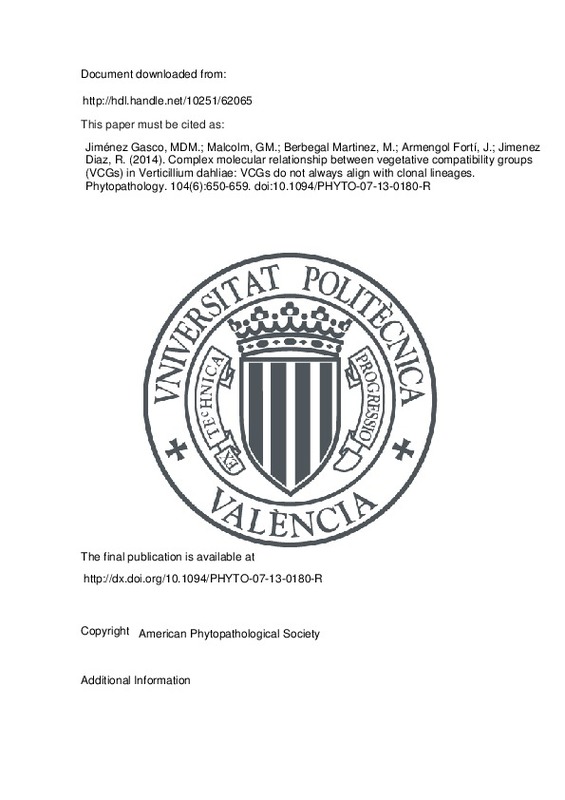JavaScript is disabled for your browser. Some features of this site may not work without it.
Buscar en RiuNet
Listar
Mi cuenta
Estadísticas
Ayuda RiuNet
Admin. UPV
Complex molecular relationship between vegetative compatibility groups (VCGs) in Verticillium dahliae: VCGs do not always align with clonal lineages
Mostrar el registro sencillo del ítem
Ficheros en el ítem
| dc.contributor.author | Jiménez Gasco, María del Mar
|
es_ES |
| dc.contributor.author | Malcolm, Glenna M.
|
es_ES |
| dc.contributor.author | Berbegal Martínez, Mónica
|
es_ES |
| dc.contributor.author | Armengol Fortí, Josep
|
es_ES |
| dc.contributor.author | JIMENEZ DIAZ, RAFAEL
|
es_ES |
| dc.date.accessioned | 2016-03-29T14:23:32Z | |
| dc.date.available | 2016-03-29T14:23:32Z | |
| dc.date.issued | 2014-06 | |
| dc.identifier.issn | 0031-949X | |
| dc.identifier.uri | http://hdl.handle.net/10251/62065 | |
| dc.description.abstract | Verticillium wilts caused by the soilborne fungus Verticillium dahliae are among the most challenging diseases to control. Populations of this pathogen have been traditionally studied by means of vegetative compatibility groups (VCGs) under the assumption that VCGs comprise genetically related isolates that correlate with clonal lineages. We aimed to resolve the phylogenetic relationships among VCGs and their subgroups based on sequences of the intergenic spacer region (IGS) of the ribosomal DNA and six anonymous polymorphic sequences containing single-nucleotide polymorphisms (VdSNPs). A collection of 68 V dahliae isolates representing the main VCGs and subgroups (VCGs 1A, 1B, 2A, 2B, 3, 4A, 4B, and 6) from different geographic origins and hosts was analyzed using the seven DNA regions. Maximum parsimony (MP) phylogenies inferred from IGS and VdSNP sequences showed five and six distinct clades, respectively. Phylogenetic analyses of individual and combined data sets indicated that certain VCG subgroups (e.g., VCGs 1A and 1B) are closely related and share a common ancestor; however, other subgroups (e.g., VCG 4B) are more closely related to members of a different VCG (e.g., VCG 2A) than to subgroups of the same VCG (VCG 4B). Furthermore, MP analyses indicated that VCG 2B is polyphyletic, with isolates placed in at least three distinct phylogenetic lineages based on IGS sequences and two lineages based on VdSNP sequences. Results from our study suggest the existence of main VCG lineages that contain VCGs 1A and 1B; VCGs 2A and 4B; and VCG 4A, for which both phylogenies agree; and the existence of other VCGs or VCG subgroups that seem to be genetically heterogeneous or show discrepancies in their phylogenetic placement: VCG 2B, VCG 3, and VCG 6. These results raise important caveats regarding the interpretation of VCG analyses: genetic homogeneity and close evolutionary relationship between members of a VCG should not be assumed. | es_ES |
| dc.description.sponsorship | This research was partially funded by the Sarah Chinn Kalser Faculty Research Assistance Endowment, College of Agricultural Sciences, The Pennsylvania State University. We thank all suppliers of V. dahliae isolates; J. Yanez, S. Colihan, C. Barrett, C. Black, and C. Olivares-Garcia for excellent technical support; and D. Geiser for helpful discussions during the preparation of this manuscript. | en_EN |
| dc.language | Inglés | es_ES |
| dc.publisher | American Phytopathological Society | es_ES |
| dc.relation.ispartof | Phytopathology | es_ES |
| dc.rights | Reserva de todos los derechos | es_ES |
| dc.subject | Polymerase chain reaction | es_ES |
| dc.subject | Genetic diversity | es_ES |
| dc.subject | Heterokaryon incompatibility | es_ES |
| dc.subject | Tester strains | es_ES |
| dc.subject | DNA sequence | es_ES |
| dc.subject | Wilt | es_ES |
| dc.subject | Potato | es_ES |
| dc.subject | Populations | es_ES |
| dc.subject | Olive | es_ES |
| dc.subject.classification | BOTANICA | es_ES |
| dc.subject.classification | PRODUCCION VEGETAL | es_ES |
| dc.subject.classification | ECOSISTEMAS AGROFORESTALES (UPV) | es_ES |
| dc.title | Complex molecular relationship between vegetative compatibility groups (VCGs) in Verticillium dahliae: VCGs do not always align with clonal lineages | es_ES |
| dc.type | Artículo | es_ES |
| dc.identifier.doi | 10.1094/PHYTO-07-13-0180-R | |
| dc.rights.accessRights | Abierto | es_ES |
| dc.contributor.affiliation | Universitat Politècnica de València. Departamento de Ecosistemas Agroforestales - Departament d'Ecosistemes Agroforestals | es_ES |
| dc.contributor.affiliation | Universitat Politècnica de València. Instituto Agroforestal Mediterráneo - Institut Agroforestal Mediterrani | es_ES |
| dc.description.bibliographicCitation | Jiménez Gasco, MDM.; Malcolm, GM.; Berbegal Martinez, M.; Armengol Fortí, J.; Jimenez Diaz, R. (2014). Complex molecular relationship between vegetative compatibility groups (VCGs) in Verticillium dahliae: VCGs do not always align with clonal lineages. Phytopathology. 104(6):650-659. doi:10.1094/PHYTO-07-13-0180-R | es_ES |
| dc.description.accrualMethod | S | es_ES |
| dc.relation.publisherversion | http://dx.doi.org/10.1094/PHYTO-07-13-0180-R | es_ES |
| dc.description.upvformatpinicio | 650 | es_ES |
| dc.description.upvformatpfin | 659 | es_ES |
| dc.type.version | info:eu-repo/semantics/publishedVersion | es_ES |
| dc.description.volume | 104 | es_ES |
| dc.description.issue | 6 | es_ES |
| dc.relation.senia | 279657 | es_ES |
| dc.contributor.funder | College of Agricultural Sciences, Pennsylvania State University | es_ES |







![[Cerrado]](/themes/UPV/images/candado.png)

